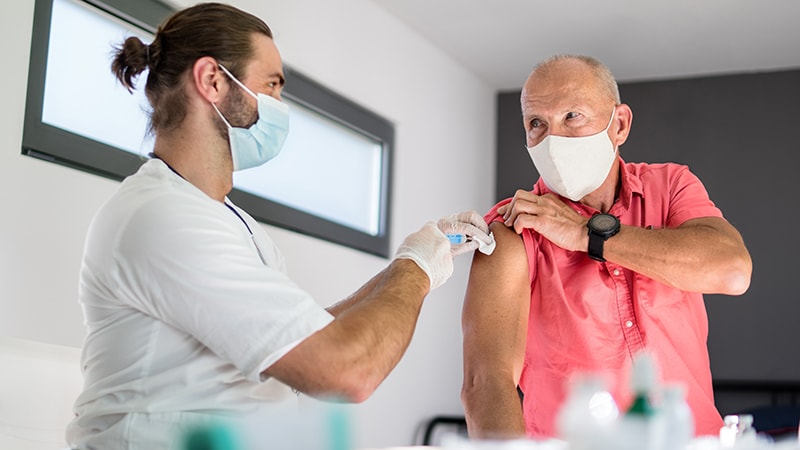Recruitment has begun in the UK for a world-first study to investigate whether using different COVID-19 vaccines for first and second doses is as effective as using the same type of vaccine for both.
If successful, the practice of using doses interchangeably would improve flexibility for mass immunisation and protect against disruption in vaccine supply, scientists behind the study said.
They also raised the possibility that a heterologous prime-boost vaccination regimen might even provide better protection against COVID-19 than using the same vaccine for two doses.
Study Will Run for More Than a Year
Work began today on recruiting 820 participants to take part in the 13-month randomised control study, run by the National Immunisation Schedule Evaluation Consortium.
The COVID-19 Heterologous Prime Boost study (Com-Cov) trial will initially concentrate on the two vaccines currently in community use in the UK: Pfizer/BioNTech and AstraZeneca/Oxford.
It will also gather immunological evidence on different intervals (28 days v 12 weeks) between the first and second dose for a mixed-vaccine regimen against control groups where the same vaccine is used for both doses.
The trial, taking place at eight different sites in England, will test eight different combinations. These are:
- Two doses of the AstraZeneca/Oxford vaccine at 28 days apart
- Two doses of the AstraZeneca/Oxford vaccine at 12 weeks apart – as a control group
- Two doses of the Pfizer/BioNTech vaccine at 28 days apart
- Two doses of the Pfizer/BioNTech vaccine at 12 weeks apart – as a control group
- The AstraZeneca/Oxford vaccine for the first dose, followed by the Pfizer/BioNTech vaccine for the second, at 28 days apart
- The AstraZeneca/Oxford vaccine for the first dose, followed by the Pfizer/BioNTech vaccine for the second, at 12 weeks apart
- The Pfizer/BioNTech vaccine for the first dose, followed by the AstraZeneca/Oxford vaccine for the second, at 28 days apart
- The Pfizer/BioNTech vaccine for the first dose, followed by the AstraZeneca/Oxford vaccine for the second, at 12 weeks apart
"We're starting off with these two vaccine candidates, but it is the intention that we would add additional vaccine candidates as they become available for routine use," said Prof Matthew Snape from the Oxford Vaccine Group, who is chief investigator on the trial.
Blood samples from participants will be taken over time to measure antibody levels.
Study Will Inform Future Vaccine Programmes
Dr Mary Ramsay, head of immunisation at Public Health England, said it was important to establish "proof of principle" that a heterologous prime-boost vaccination regimen would be effective at protecting people from COVID-19.
She told a briefing hosted by the Science Media Centre: "If they do work well together, and they may actually work better than the two same vaccines, then that will be really useful, both for the UK and globally, in terms of how we can implement programmes, how we can make the programmes as accessible as possible."
Prof Jonathan Van-Tam, England's deputy chief medical officer, commented: "Given the inevitable challenges of immunising large numbers of the population against COVID-19 and potential global supply constraints, there are definite advantages to having data that could support a more flexible immunisation programme, if needed and if approved by the medicines regulator.
"It is also even possible that by combining vaccines, the immune response could be enhanced, giving even higher antibody levels that last longer.
Unless this is evaluated in a clinical trial we just won't know."
Prof Snape said there was emerging evidence to suggest that mixing the vaccination schedule could result in better protection. "You can see better response with a mix of RNA and viral vectored responses," he told the briefing.
Asked whether the researchers were concerned about safety in mixing and matching different vaccines, Prof Snape said: "We're not expecting that that would actually greatly increase the risk of any unexpected reactions or side effects, but we will be looking carefully for that."
Government Funding
Study recruits will be selected from the NHS COVID-19 Vaccine Registry. "We're keen to recruit people over the age of 50, and people with comorbidities, and people of diverse ethnic backgrounds," said Dr Maheshi Ramasamy, a consultant physician and senior clinical researcher at the Oxford Vaccine Group.
The study has been classified as an Urgent Public Health study and has been granted funding of £7 million from the Government through the Vaccines Taskforce.
Nadhim Zahawi, minister for COVID-19 vaccine deployment said: "This is a hugely important clinical trial that will provide us with more vital evidence on the safety of these vaccines when used in different ways.
"Nothing will be approved for use more widely than the study, or as part of our vaccine deployment programme, until researchers and the regulator are absolutely confident the approach is safe and effective."
Interim results from COM-COV are expected during the summer.
Commenting on the study, Dr Andrew Garrett, executive vice president of scientific operations at ICON Clinical Research, said: "There remain many unanswered questions, and new questions will emerge, so it is important for the UK to create an experimental framework to continue to gather objective vaccine evidence to support public health policy.
"This trial represents an important step in the right direction."
Dr Peter English, a consultant in communicable disease control, welcomed the investigation into standard and longer intervals between doses. He said: "The short prime-boost interval in the initial vaccine trials was presumably chosen because the efficacy of vaccination after a single dose was not predicted to be as high as it has turned out to be, to provide better initial immunity, at the expense of longer-term immunity.
"So that the trial is looking at different intervals is interesting and should yield some valuable data."





